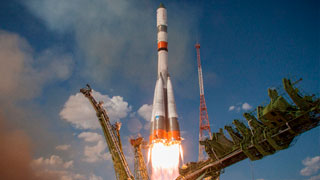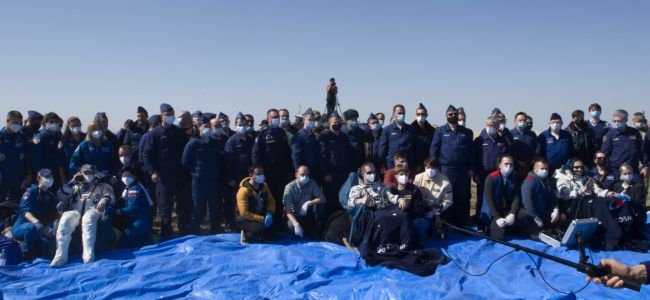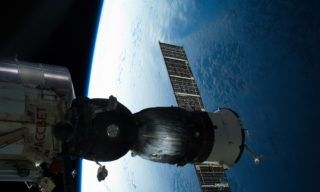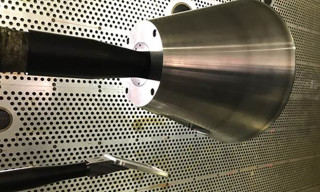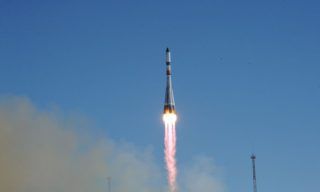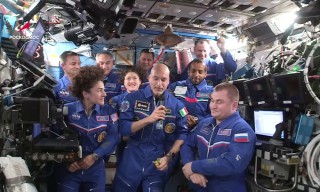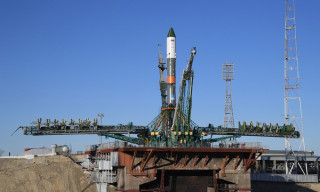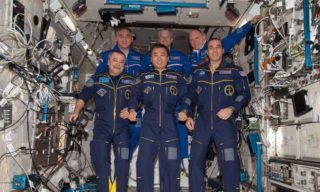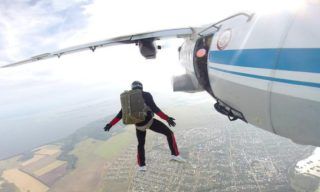Early Saturday morning of April 17, 2021, the Soyuz MS-17 crewed ship descent vehicle, which undocked from the International Space Station, routinely landed at the precalculated point in Kazakhstan. The crew of the 64th long-term expedition consisting of Roscosmos cosmonauts Sergey Ryzhikov and Sergey Kud-Sverchkov, as well as NASA astronaut Kathleen Rubins returned to Earth.
All descent operations and landing went normally and the crew is feeling well. The ship undocked from the Russian segment of the station at 03:34 UTC. Its propulsion system performed a braking impulse at 04:01 UTC, after which the ship began to descend. Shortly thereafter, the Soyuz split into three compartments, and the international crew in the descent vehicle experienced overloads of about 3,8g.
Today Sergey Ryzhikov and Sergey Kud-Sverchkov will be delivered by a charter flight to the Chkalovsky airfield (Moscow region). For several weeks, they will stay in the Complex for prelaunch training and post-flight rehabilitation of cosmonauts (astronauts) in Star City (Moscow Region). Doctors will monitor the health of the Russian crewmembers of the Soyuz MS-17 spacecraft.
The Soyuz-2.1a carrier rocket with the Soyuz MS-17 crewed vehicle was launched on October 14, 2020 at 05:45:04 UTC. 3 hours 3 minutes later, at 08:48:47 UTC, it docked routinely to the Rassvet module of the Russian segment of the International Space Station. For the first time in the world, a crewed spacecraft docked to the ISS, after only two orbits around the Earth. Sergey Ryzhikov, Sergey Kud-Sverchkov and Kathleen Rubins spent 185 days in space. The crew performed dozens of experiments in various fields of science according to the Russian scientific program (medicine, space biology, biotechnology, physicochemical processes, etc.). Thus, during the six-month expedition, the Russian crewmembers of the ISS-64 conducted 44 experiments, of which 41 involving the cosmonauts. The crew spent 579.5 hours on the research program. At the same time, 614 sessions of experiments were conducted, of which 501 involving the cosmonauts.
A crew of three was on board the International Space Station from October 22 to November 16, 2020: Sergey Ryzhikov (Roscosmos), Sergey Kud-Sverchkov (Roscosmos) and Kathleen Rubins (NASA). From November 17, 2021 to April 8, 2021, the crew consisted of seven people: Sergey Ryzhikov, Sergey Kud-Sverchkov, Kathleen Rubins, Michael Hopkins (NASA), Victor Glover (NASA), Soichi Noguchi (NASA) and Shannon Walker (NASA ). From April 9 to April 17, a crew of ten was on the ISS: Sergey Ryzhikov, Sergey Kud-Sverchkov, Kathleen Rubins, Michael Hopkins, Victor Glover, Soichi Noguchi (JAXA), Shannon Walker, Oleg Novitsky (Roscosmos), Pyotr Dubrov (Roscosmos) and Mark Vande Hei (NASA).
During the 185-day expedition on board the ISS, the crew received the Progress MS-16, Cygnus NG-15 and Dragon SpX-21 cargo ships, as well as two crewed ones: Dragon SpX Crew-1 and Soyuz MS-18. On March 19, 2021, a re-docking of the Soyuz MS-17 crewed transport vehicle took place from the Rassvet Mini-Research Module (MIM-1) to the Poisk Mini-Research Module to enable the Soyuz MS-18 spacecraft to dock to the MIM-1. On April 5, the Crew Dragon Resilience crewed ship was re-docked from the front airlock of the Harmony module to the upper port of the same module in order to make room for another Crew Dragon ship, Endeavor.
In November, according to the Russian program, Sergey Ryzhikov and Sergey Kud-Sverchkov performed a 6 hours and 51minutes long spacewalk to prepare for the launch and subsequent docking of the Nauka laboratory module. Five spacewalks were performed under the American program: on January 27 (Michael Hopkins and Victor Glover lasting 6 hours 55 minutes), February 1 (Michael Hopkins and Victor Glover lasting 5 hours 18 minutes), February 28 (Kathleen Rubins and Victor Glover lasting 7 hours 6 minutes), March 5 (Kathleen Rubins and JAXA Soichi Noguchi, 6 hours 54 minutes) and March 13 (Michael Hopkins and Victor Glover, 6 hours 47 minutes).
The completed mission was the second in the career of Roscosmos cosmonaut Sergey Ryzhikov. His first flight to low-earth orbit as the Soyuz MS-02 crewed spacecraft commander and the ISS-49/50 expedition flight engineer lasted 173 days. On November 13, 2018, Sergey Ryzhikov was awarded the title of Hero of Russia with the Golden Star medal for his courage and heroism during the space flight.
For Sergey Kud-Sverchkov, the flight as the Soyuz MS-17 flight engineer and the ISS-64 expedition was the debut in his space career. It took him 10 years to make his dream come true: on November 15, 2010, in accordance with the order of the head of the Gagarin Cosmonaut Training Center No. 469 of November 15, 2010 he began a year and a half general space training. On August 3, 2012, at a meeting of the Interdepartmental Qualification Commission for the Assessment of the Training of Candidates for Test Cosmonauts, he received the test cosmonaut qualification. On May 29, 2020, by the decision of the Roscosmos Interdepartmental Commission, he was approved as the Soyuz MS-17 crewed spacecraft prime crew flight engineer.
Despite his busy work schedule, Sergey Kud-Sverchkov also found time to publish photographs and videos of space scientific experiments on social networks VKontakte, Twitter and Instagram, thanks to which thousands of people around the world have become even closer to space.
For flight engineer-2 Kathleen Rubins, this was also not the first flight into low-earth orbit. For the first time, she launched on July 7, 2016 as the Soyuz MS spacecraft flight engineer-2 together with Roscosmos cosmonaut Anatoly Ivanishin and JAXA astronaut Takuya Onishi. During the flight, she performed two spacewalks. On October 30, 2016, the spacecraft descent vehicle landed on the territory of Kazakhstan, 148 km southeast of the city of Dzhezkazgan.
The crew of the 65th long-term expedition, consisting of Roscosmos cosmonauts Oleg Novitsky and Pyotr Dubrov, NASA astronauts Michael Hopkins, Victor Glover, Shannon Walker, Mark Vande Hei and JAXA astronaut Soichi Noguchi, is currently working on board the International Space Station. Shortly before his return, Sergey Ryzhikov handed over the station command to Shannon Walker. On April 22, 2021, a Falcon 9 launch vehicle is to launch from Cape Canaveral delivering the Crew Dragon USCV-2 crew of Shane Kimbrow, Megan MacArthur, Akihiko Hoshide and Tom Peske, to the station.


